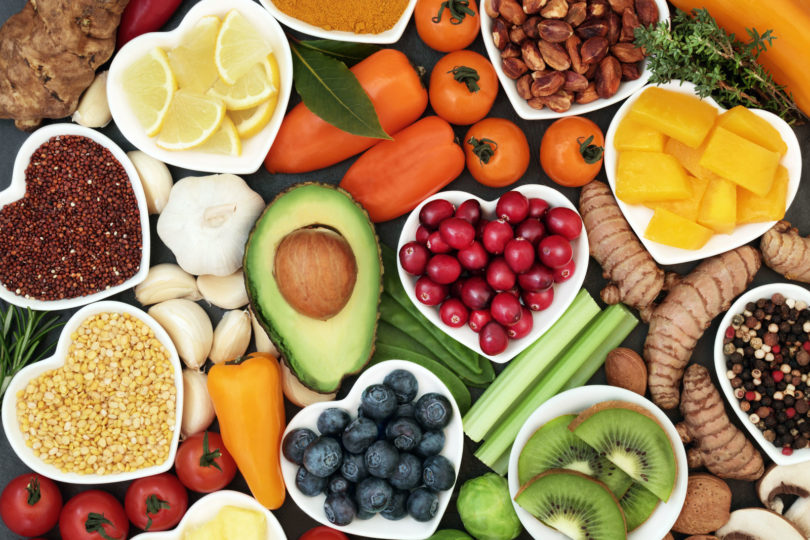Studies show — and waistlines prove — that adults don’t eat as many fruits and vegetables as they should. So use the summer’s bounty of fresh produce as the perfect time to toss out those chips and replace them with refreshing cucumber and crispy green beans. A 2017 study by the Centers for Disease Control and Prevention revealed that only 1 in 10 adults met the recommended daily value of 1.5-2 cups of fruit and 2-3 cups of vegetables. So you aren’t alone in needing to boost your plant consumption. Of course, to eat more vegetables, you must have them in your kitchen, and that means changing your purchasing habits. Grocery stores have made it easy; the produce always greets you near the entrance. Although a well-stocked produce section can be daunting, you can always find some family favorites such as cherry tomatoes or baby carrots.
Below are seven vegetables to add to your summer plate. Vegetables fall into several major groupings, each of which shares common nutritional benefits. The quick and easy recipes included will help you expand your vegetable repertoire.
Sweet Potatoes
Despite their name, sweet potatoes are not relatives of the regular potato, but a cousin of the morning glory flower. As such, they have a lower glycemic index than potatoes, making them a better choice to regulate your blood sugar. One sweet potato provides you with a whopping 377 percent of your daily recommended Vitamin A and provides 4 grams of fiber.
Quick recipe:
Peel, slice into 1/8-inch pieces and grill on a Panini maker for 5 minutes or until slightly browned and crispy. Salt and serve with fat-free sour cream mixed with Sriracha sauce.
Mushrooms
White button mushrooms provide you with 45 percent of your recommended daily Vitamin B and are a good source of minerals. Because mushrooms are fungus, rather than actually plants, they are the only vegetable that produces Vitamin D when exposed to sunlight, so look for sunlight-enhanced mushrooms soon. For unexpected flavors and textures, branch out and try different varieties such as crimini, Portobello, oyster or shiitake.
Quick recipe:
Clean, slice and sauté mushrooms in olive oil, with a touch of butter. These can be made ahead of time and stored in the fridge for a few days. Serve as a side dish, or add them to your breakfast eggs or marinara sauce. Tip: To avoid soggy mushrooms, when washing, wipe with a paper towel instead of drenching.
Cauliflower
Cauliflower is a form of the same plant species as Brussels sprouts, cabbage, kale and broccoli, so they all contain the cancer-fighting phytonutrient — sulforaphane. Half of the fiber in cruciferous vegetables is soluble, meaning it slows the absorption of sugar and cholesterol and helps your gut bacteria. Most people would mistakenly identify citrus as the best source of Vitamin C, but one cup of cauliflower provides 85 percent of the recommended daily amount.
Quick recipes:
Cauliflower rice: Wash raw cauliflower; chop to fit in your food processor, then blend into fine pieces. Sauté with olive oil in a skillet until golden. Remove, season with salt and pepper and serve as a delicious side.
Chop raw head of cauliflower into 1-2-inch florets, then place on baking sheet, baste with olive oil and broil until golden brown. Toss with the juice of one lemon, 1/3 cup chopped Kalamata olives, 1 teaspoon capers and a handful chopped fresh parsley; add salt and black pepper to taste.
Eggplant
Like tomatoes, potatoes and peppers, eggplant is a member of the nightshade family of plants. They are high in fiber and low in calories (only 20 calories per cup), making them filling. Their absorbent flesh will soak up as much oil as you pour on it, so it’s healthiest to dry roast them.
Quick recipes:
Skin eggplant and slice into 1/2-inch thick pieces. Place on cooking sheet; brush both sides of the slice with olive oil if you must, but they are fine without it. Broil until golden brown. Season as your like: salt, parsley, basil and capers all are delicious!
To make baba ganoush, add tahini and garlic to the broiled eggplant slices (skin removed), then blend in food processor with the juice of one lemon and salt to taste. Serve with pita bread or baby carrots.
Zucchini
Like eggplant, zucchini is technically a fruit. Modest-sized zucchini with the flower still attached are sweeter and less fibrous than the larger ones. One cup of zucchini has only 21 calories and provides 9 percent of the recommended daily amount of potassium — almost as much as a banana.
Quick recipes:
Use as a substitute for noodles. Wash zucchini, create noodle shapes with a spiralizer, sauté with olive oil and garlic and serve with marinara sauce.
Craving nachos? To save yourself carbs and calories, pile your toppings on a flattened bed of zucchini noodles instead of using a tortilla.
Cucumber
Cucumbers are closely related to zucchini, are 95 percent water and therefore are also low in calories. One cup of cucumber gives you 32 percent of your daily value of Vitamin K. With their satisfying crunch and freshness, they are perfect for a quick snack or for a nice garnish in water. In summer you can find unwaxed cukes — try eating them with the skin for more flavor and nutrition.
Quick recipe:
Wash one cucumber, finely dice and place in a bowl. With an equal amount of tomato, wash and finely dice; add to the cucumber. Juice one lemon, pour on cucumber and tomatoes, then add 1 teaspoon of olive oil, lots of salt and black pepper.
Green Beans
The green beans that we eat are the unripe and immature pods of one of 130 types of edible green beans. Look for fresh beans that snap when you break them. One cup of green beans has only 31 calories and 30 percent of the daily recommended Vitamin C.
Quick recipe:
Prepare beans by cutting off the stem end and blanching quickly in boiling water. Drain and rinse with cold water to stop the cooking process. In a bowl, add chopped tomatoes, a touch of olive oil, garlic, salt & pepper and your favorite vinegar. Let marinate for a few hours in the fridge and serve cold.
If you really want to be adventurous, inspiration can be found at your local farmer’s market — where there are heaps of lettuce, eggplant and peppers in varieties that you might have never seen at the grocery store. Enjoy the fresh air and connect with your neighbors while shopping outdoors. Get to know the person who nurtures your food from seedling to edible plant.


